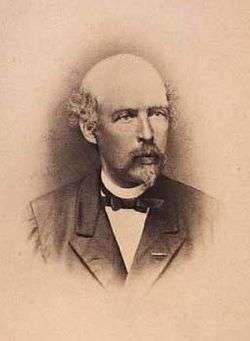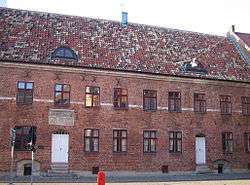Rosenvinge (noble family)

Photographer: Hansen & Weller
.jpg)
Painter: unknown
Rosenvinge (lit. ‘Rose Wing’) is a Danish and Norwegian noble family. Mogens Jensen was in 1505 ennobled by the King. From the family descends also the noble family Kolderup-Rosenvinge.
Origin
Rosenvinge in Denmark
The family's progenitor, Mogens Jensen († 1528), who was Prince Christian's secretary, later overlord in Bergenhus and Mayor of Helsingør, was ennobled on 31 May 1505. He married Anna Pedersdatter, who was the daughter of Peder Hansen, Mayor of Helsingør, who himself had been ennobled in 1476 by Christian I of Denmark.
Mogens Jensen was the father of Henrik Mogensen. His patrilineal grandson Mogens Henriksen (1540–1607) was Mayor of Odense. Mogen Henriksen's sons Jørgen Mogensen (1570–1634), Mayor of Odense, and Jens Mogensen, City Manager of Odense, became the progenitors of, respectively, the Norwegian branch and the Danish branch of the family.
Rosenvinge in Norway
Jørgen Mogensen Rosenvinge (1570–1634) was the patrilineal great-grandfather of Lord Peder Kaasbøl Rosenvinge (1701–1766), priest to Selbu, and Lord Eiler Schøller Rosenvinge (1703–1776), priest to Frosta.
Peder Kaasbøl Rosenvinge was the father of Lord Jacob Christian Rosenvinge (1737–1812), priest to Ytterøy, and Eiler Hagerup Rosenvinge (1742–1805), Mayor of Bergen. His daughter Susanne Kaasbøl Rosenvinge (1738–1771) married Jesper Andreas Kolderup, and their son, General Director of the Post Peter Andreas Rosenvinge Kolderup (1761–1824) was in 1811 ennobled under the name Kolderup-Rosenvinge.
Eiler Schøller Rosenvinge was the father of Eiler Schøller Rosenvinge (1758–1818), major in Fredrikstad, Johannes Gunnerus Rosenvinge (1759–1833), ‘overvraker ’in Trondheim, Johannes Gunnerus Rosenvinge (1759–1833), rittmeister, Jørgen Coldevin Rosenvinge (1764–1842), major and proprietarian at Rosenborg by Trondheim, and Isach Georg Rosenvinge (1767–1840), rittmeister and proprietarian at Egge by Steinkjer. Eiler Schøller Rosenvinge the younger had together with three different wives several illegitimate children, who adopted the name Rosenvinge. Jørgen Coldevin Rosenvinge was the father of Johannes Rosenvinge (1804–1727), painter, and Abraham Bredahl Rosenvinge (1810–1884), meteorologist and proprietarian at Rosenborg.
Eiler Schøller Rosenvinge
One of the Norwegian branch's more prominent persons is Lord Eiler Schøller Rosenvinge. Rosenvinge was employed as a vice-pastor by his cousin, Eiler Hagerup, who was bishop in Nidaros. This was not without controversy, as Hagerup and Rosenvinge were cousins and the bishop was known for favourising his relatives.
Eiler Rosenvinge received as a priest much criticism, and he was by Ludvig Daae described as «a very bad priest»[1] Rosenvinge had a big family, held a splendid household, and participated actively in the social life of the local aristocracy. Parallelly, his priest duties were given lower prioritation. His lacking attention for clerical matters, and his bad treatment of church visitors, were the subject of many letters of complaint. Among the many complaints were 1st) too high payment for various church ceremonies, 2nd) his unwillingness to give confession and communion to people with poor Bible knowledge, and 3rd) the case in which he refused the girl Olava Richter to receive her confirmation since she did not have some dollars to give to the priest, and furthermore he said that if she knew the whole Bible by heart, she were a child of the Devil. After about forty years as a priest, Rosenvinge was removed from his office due to a sentence in the Highest Court.
Together with his two wives, Eiler Rosenvinge had respectively 11 and 13 children, altogether 24. Thereby, he beat his brother Peder Kaasbøl Rosenvinge, who had 19. When Rosenvinge died, he left values for 18,581 riksdaler, which was an considerable amount in those days.
See also
References
- ↑ Norwegian: en meget slet Præst
Literature
- Store norske leksikon: Rosenvinge
- Christiansen, Per R.: Frostaboka Vol 3. Frosta historielag, 1989.
- Grandjean, Poul Bredo: Rosenvinge in Christian Blangstrup (editor), Salmonsens Konversationsleksikon. Copenhagen, J.H. Schultz Forlag 1915–30.
- Moksnes, Leif: Frostaboka Vol 2. Frosta historielag, 1970.
- A. Thiset og P.L. Wittrup: Nyt dansk Adelslexikon, Copenhagen 1904
- Sven Tito Achen: Danske adelsvåbener, Copenhagen 1973
